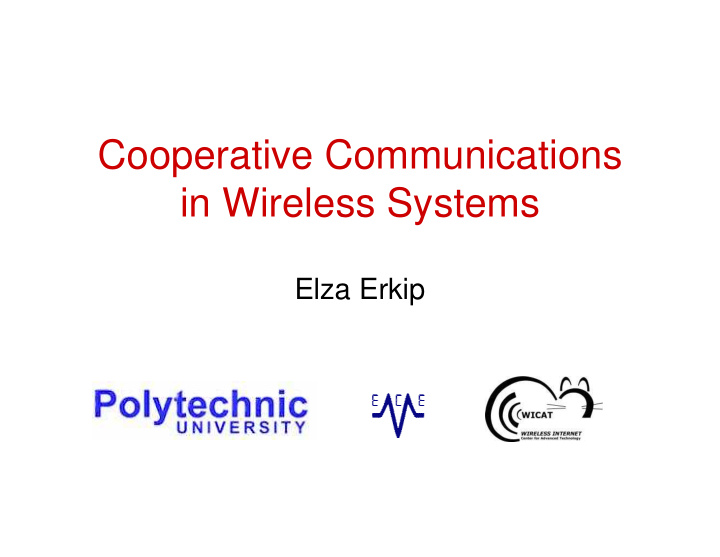



Cooperative�Communications� in�Wireless�Systems Elza Erkip
Wireless�Networks Ad-hoc� Network Backbone Network Wireless Cellular Wireless Cellular Wireless�LAN Wireless LAN
Outline • Relay�channel – Relaying�in�wireless:�Use�relays�for�diversity – Traditional�multihop versus�multihop with�diversity • Concept�of�cooperation:� “Virtual”�antenna�array • Information�theoretic�model�and�analysis • Cooperative�codes
Relay�Channel� • Introduced�by�Ven der Meulen (1971) • Cover�and�El�Gamal (1979):�Inner�and�outer�bounds�on�the� capacity;�capacity�of�degraded�relay�channel R S D • Multiple�relays: – Schein &�Gallager – Gupta�&�Kumar – Xie &�Kumar – Reznik,�Kulkarni &�Verdu – Gastpar &�Vetterli – Gastpar,�Kramer�&�Gupta
Multi-hop�Wireless�Communications • Multi-hop�reduces�power�requirements�and�interference d d Source Relay Destination ( ) α α α = = P P d Pd § Direct�transmission: 2 2 total α = P Pd 2 § Relayed�transmission:�� total • Current�trends: – Only�consider�path�loss – Destination�only�processes�signal�from�relay • What�about�fading?�Use�multi-hop�for�diversity.
Diversity�in�Multihop • One�source/destination,�two�relays distance s R1 R2 D • Path�loss�and�fading • Uncoded BPSK,�bit�by�bit�processing – Relays�amplify�received�signal�and�forward S S S • Direct� time S R 1 R 2 • Via�relays� time – Total�power�divided�equally�among�source�and�relays
Effect�of�Multihop Diversity 0 10 -1 10 -2 10 -3 BER 10 -4 10 -5 Direct�tx.��� 10 Multihop�tx.� Diversity�tx. Tx.�div.�3��� -6 10 0 2 4 6 8 10 12 SNR�(dB)
User�Cooperation�Diversity • Diversity�through�cooperation�of�mobiles (Sendonaris,�Erkip,�Aazhang) • Two�main�ideas – Use�relays�to�provide�diversity� – Collaborative�scheme:�Both�mobiles�help�each�other� (“partners”)
User�Cooperation • Mobile�antennas�are�omnidirectional – Signals�transmitted�towards�the�destination�can�be�“overheard”� at�the�partner – Partners�process�this�overheard�information�and�re-transmit� towards�the�destination • Total�resources�(power,�bandwidth)�are�same�as�non-cooperative�case – Destination�processes�signals�from�both�mobiles • Spatial�diversity�through�partner’s�antenna,�a�“virtual”� antenna�array – Inter-user�channel�is�noisy!
Approach • Information�theory� (Sendonaris,�Erkip,�Aazhang) – A�general�model�illustrating�that�cooperation� results�in�throughput�and�diversity�gains – Some�idealized�assumptions • Code�design� (Stefanov,�Erkip) – More�realistic�assumptions� – Channel�codes�that�exploit�user�cooperation�gains
Information�Theoretic�Model K User�1 X W 10 E 1 1 Y 1 2 K 12 Z Z 1 Y D Z 2 K 21 Y 1 E W User�2 2 X 2 K 2 20 • K� ij :�Fading�amplitudes • Receivers�track�the�fading�parameters,�transmitters�don’t
Capacity�Analysis • Assumptions – Partners�receive�and�transmit�at�the�same�time� (same�assumption�as�classical�relay�of�Cover�&�El�Gamal) – Transmitters�have�phase�information:�Coherent� combining�is�possible • Model�is�similar�to�multiple�access�channel� with�generalized�feedback – DMC�and�Gaussian� (Carleial,�Willems et.al.) • Achievable�region�under�fading
Transmit�Signal�Structure • Information�W 1 =�(W 10 ,W 12� ) • Signal���X 1 =�(X 10 ,X 12� ,U 1 ) – X 10� :�Send�W 10 at�rate�R 10 to�destination�(D) – X 12� :�Send�W 12 at�rate�R 12 to�mobile�2�(also�heard�at�D) – U 1� :�Cooperative�signal�based�on�(W 12 ,W 12� )�to�the�BS • Power�allocation:�P 1� =�P 10 +P 12� +P U1
Achievable�Rate�Region�with�Cooperation = + = + R R R R R R R R {( , ) | , } The�closure�of� where 1 2 1 10 12 2 20 21 K P 2 � � � � < = R C k k k 0 0 E 1 , 2 � � k � � 0 N � � � � � � K P 2~ � � � � ~ < � � = R C k k k k k E 1 , 2 � � ~ � � k k + K P N 2 � � ~ k k � � k k 0 � � � � + K P K P 2 2 � � � � + < R R C 10 10 20 20 E � � � � 10 20 N � � � � � � + + K P K P K K P P 2 2 2 � � � � + + + < � U U � R R R R C 10 1 20 2 10 20 1 2 E � � � � 10 20 12 21 N � � � � � � � � for�some�power�assignment = + + = + + P P P P P P P P , U U 1 10 12 1 2 20 21 2
Achievable�Rate�Region�(Symmetric)
Achievable�Rate�Region�(Asymmetric)
Probability�of�Outage
Benefits�of�Cooperation • Higher�data�rates For�both�mobiles • Reduced�outage Provides�an�incentive�for�relaying� • Increased�battery�life • Extended�coverage�for�cellular • Works�even�when�inter-user�channel�is�bad�or�one� user�is�closer�to�the�base�station
Realistic�Constraints • Hard�to�transmit/receive�at�the�same�time – Without�cooperation N N M2 M1 – With�cooperation N/2 N/2 N/2 N/2 M1 M2�for�M1 M2 M1�for�M2
Cooperation�Using�Time-Sharing� ( Laneman,�Tse,�Wornell ) • Works�for�same/separate�receivers • Outage�probability�analysis�for�slow�fading • Partner�can – Amplify�and�forward • Amplifies�noise,�two�level�diversity – Decode�and�forward • Perfect�decoding�is�a�strict�constraint,�one�level�diversity – Adaptive�decode�and�forward • Partner�decodes�only�when�it�can,�two�level�diversity • Channel�codes�for�cooperation?
Channel�Coding�for�Cooperation (Stefanov,�Erkip) N/2 N/2 N/2 N/2 - With�cooperation M1 M2�for�M1 M2 M1�for�M2 ���������������������� ������������� �������������� ���������������������� ������ • To�cooperate,�M1�only�transmits�half�of�its�coded�bits. • This�is�received�at�M2�and�at�the�destination.�� • M2�decodes�M1’s�information,�re-encodes�and�transmits�remaining�half� of�the�coded�bits. • M2�forwards�only�when�it�has�correct�information�(checked�by�CRC),�otherwise M1�continues.� • Protocol�similar�to� Hunter�&�Nosratinia.
Block�Fading�Model • Quasi-static�channels Block�fading�when�cooperation�takes�place • Can�use�codes�designed�for�block�fading�channels� (Knopp &�Humblet) – Maximize�diversity�and�coding�advantages� • Additional�constraints – First�half�of�the�code�has�to�be�good�in�the�quasi-static�inter- user�channel – Code�has�to�be�good�in�the�quasi-static�channel�when� cooperation�does�not�take�place N/2 N/2 M1 M2�for�M1
Cooperative�Coding�Performance�Analysis • Frame�error�rate�with�the�above�cooperation�protocol C = − in BF + in QS P P P P P ( 1 ) f f f f f ≤ + BF in QS P P P f f f K K K QS ≤ + BF in SNR SNR SNR SNR in 1 2 1 C :�FER�for�the�cooperative�protocol – P f in :�FER�for�inter-user�channel – P f BF :�FER�for�the�block�fading�channel�resulting�from�cooperation – P f QS :�FER�for�the�direct�(non-cooperative)�channel – P f – SNR i :�Received�SNR�for�user�i�at�the�destination,�i=1,2 – SNR in :�Received�SNR�in�the�inter-user�channel – K:�Code�parameters
Cooperative�Coding�(Similar�users)
Cooperative�Coding�(Asymmetric�case)
Effect�of�Cooperation�on�Routing M3 M1 D M2 – Traditional�routing� • Only�path�loss�is�considered:�Choose�M3�as�relay – Cooperative�diversity • For�medium-high�SNR,�M2�results�in�lower�error�rate • Good�inter-user�channel�dominates
Routing�with�Cooperative�Diversity
Other�Related�Projects�at�Poly • Cooperative�space-time�coding� (Stefanov,� Erkip) – Cooperative�codes�for�mobiles�with�multiple�antennas – Asymmetric:�Cooperation�among�mobiles�with�different� number�of�antennas�(overlay�codes) • Choice�of�partners:�Geometry�of�cooperation� (Lin,�Erkip,�Stefanov) • Diversity�in�relaying�protocols (Yuksel,�Erkip) • Visit�our�web�page:�eeweb.poly.edu/~elza
Recommend
More recommend